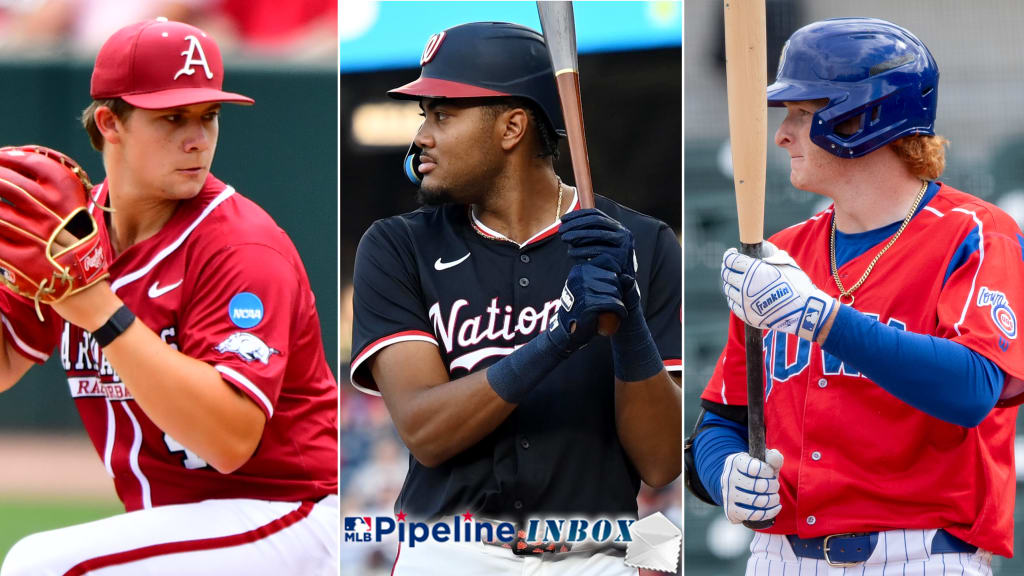
I'm back from the Draft Combine, looking forward to the College World Series finals this weekend and can sort of see the light at the end of the Draft tunnel. In 23 days, we'll know who the Nationals will take with the No. 1 overall pick. Let's answer your questions, Draft and otherwise ...
More from MLB Pipeline:
• Top 100 prospects | Stats | Video | Podcast | Complete coverage
I did get several Gage Wood questions immediately after the Arkansas right-hander pitched the best game in College World Series history, a 19-strikeout no-hitter against Murray State on Monday. Only an eighth-inning hit batter kept him from a perfect game as he got 26 swings and misses with his explosive 95-98 mph fastball and mixed in an effective power curveball at 82-85 mph.
Wood entered the season with first-round upside, made two starts and then missed nearly two months with a shoulder impingement. His stuff came back but he lacked consistency in five outings at the end of the regular season, then was dominant in two of his three NCAA tournament starts. He fanned 13 in six innings against Creighton and lasted just 3 1/3 frames without a strikeout against Tennessee before overmatching Murray State.
Wood's Draft status still is murky because he also had shoulder issues in high school and pitched just 108 innings in three seasons with the Razorbacks, leaving questions about his durability. He has one of the best fastballs in the Draft and a solid curve, though he barely employs his changeup. He has cut his walk rate to 5 percent during the last two college seasons, and his pitch efficiency bolsters his case as a starter.
My best guess is that Wood fits in the back half of the first round as the second or third college righty selected. In our latest first-round projection, a joint effort from Jonathan Mayo and me, we had him going No. 22 to the Braves.
Right now, the only Draft picks that can be traded are the competitive-balance selections after the first and second rounds. I'd love to see teams allowed to deal more choices, perhaps with restrictions such as only the top two rounds and only one or two years into the future.
Permitting more Draft picks to be traded would increase the strategy of in-season moves and add more drama to Draft Night. The Padres, Giants and Astros all sat near the bottom of MLB Pipeline's preseason farm system rankings, and letting them deal more Draft selections would give them more ammunition. Imagine the jolt the Draft would get if, say, the Cardinals suddenly announced they were trading the No. 5 overall selection in a package to acquire Sandy Alcantara.
The only downside I can see with increased Draft choice trading is that it would make my job assembling first-round projections more difficult because teams would be much more reticent about discussing their plans. But that's a sacrifice I'm willing to make.
In the previous five Drafts, the 2021 Padres did the best shuffling of bonus-pool money. They signed late-rising Jackson Merrill for $1.8 million ($770,100 under slot) in the first round, providing the bulk of the savings needed to sign tooled-up but enigmatic James Wood for $2.6 million ($1,497,300 over slot) in the second round. Merrill and Wood are already big league stars at age 22, though Wood is with the Nationals after departing in the Juan Soto trade.
The Cubs did something similar in 2022. Though Cade Horton's stock soared after a spectacular NCAA tournament, Chicago surprised most teams by selecting him at No. 7 overall. Signing Horton for $4.45 million ($1,261,000 under) freed up the cash to land Jackson Ferris for $3,005,000 ($1,343,800 over). Ferris is one of the best lefty pitching prospects in baseball and was part of the package used to get Michael Busch from the Dodgers.
In 2023, the Marlins grabbed the best high school right-hander (Noble Meyer) and left-hander (Thomas White) in the Draft, and both have blossomed into Top 100 Prospects. They pushed Meyer up to No. 10 and signed him for $4.5 million ($975,300 under), then floated White down to No. 35 and paid him $4.1 million ($1,679,100 over).
Last year, the Athletics were able to get the top guy on their board (Nick Kurtz) at No. 4 and sign him for $7 million ($1,370,800 under). That paved the way for nabbing Louisiana State stars Tommy White for $3 million ($667,900 under) and Gage Jump for $2 million ($923,100 over).
I didn't count the 2023 Tigers because they still could have gotten Kevin McGonigle without saving money on Max Clark at No. 3, or the 2024 Guardians, who were going to save in the neighborhood of $1.5 million no matter whom they took with the No. 1 overall choice.
The most likely club to deal a Top 100 Prospect looks like the Cubs. They have the best record in the National League and a trio of Top 100 dudes in Triple-A without an opening in Chicago: outfielders Owen Caissie (No. 44) and Kevin Alcántara (No. 68) and catcher Moisés Ballesteros (No. 55). I think they'll look to bolster their pitching staff and part with at least one of those guys.
So give me the 40-100 range. Dave Dombrowkski isn't afraid to trade prospects, so it wouldn't be a shock if the Phillies gave up shortstop Aidan Miller (No. 21) in the right deal, but I'll bank on the Cubs as the club surrendering the highest-rated talent.
Last summer, left-hander Robby Snelling (No. 44 at the time) was the most highly-regarded prospect to change addresses, going from the Padres to the Marlins in a deal for Tanner Scott and Bryan Hoeing. The year before, it was Kyle Manzardo (No. 37), who went from the Rays to the Guardians in exchange for Aaron Civale. So this BlueSky user set the over/under in a good spot.
Since MLB.com began evaluating prospects in 2004, Eloy Jiménez is the highest-rated Top 100 Prospect dealt during the season. He ranked No. 7 when the Cubs shipped him to the White Sox as the headliner in a trade for Jose Quintana in 2017.
